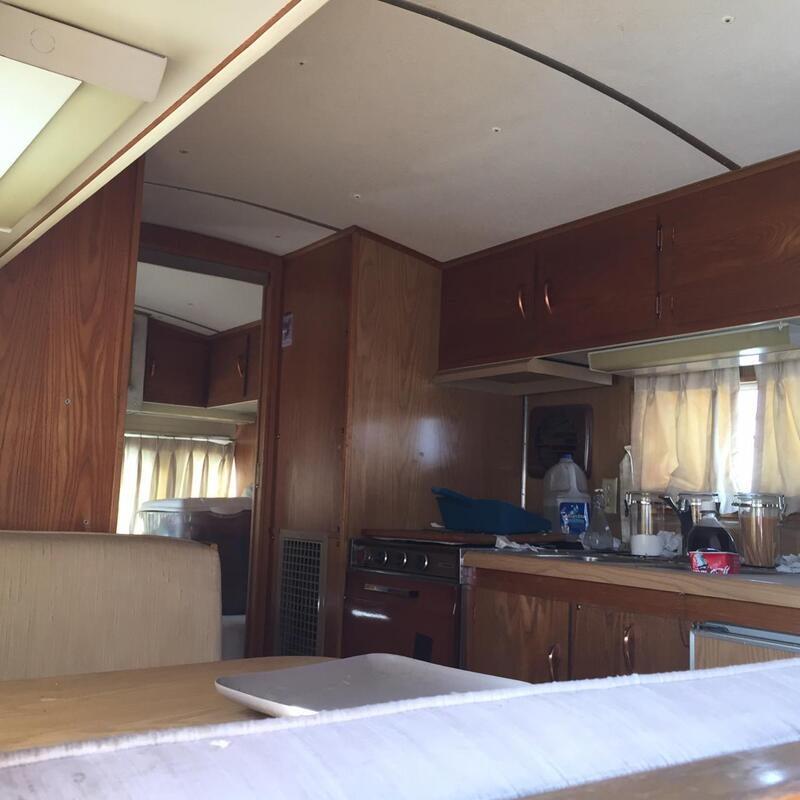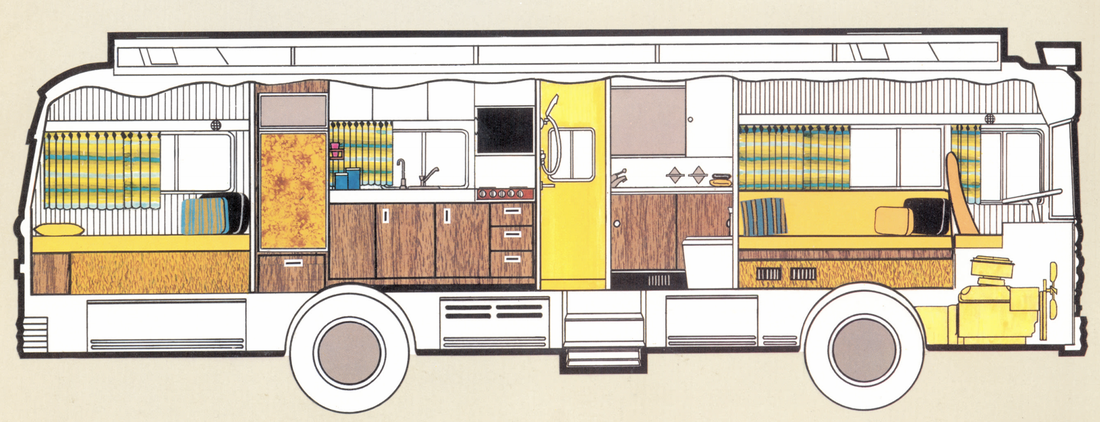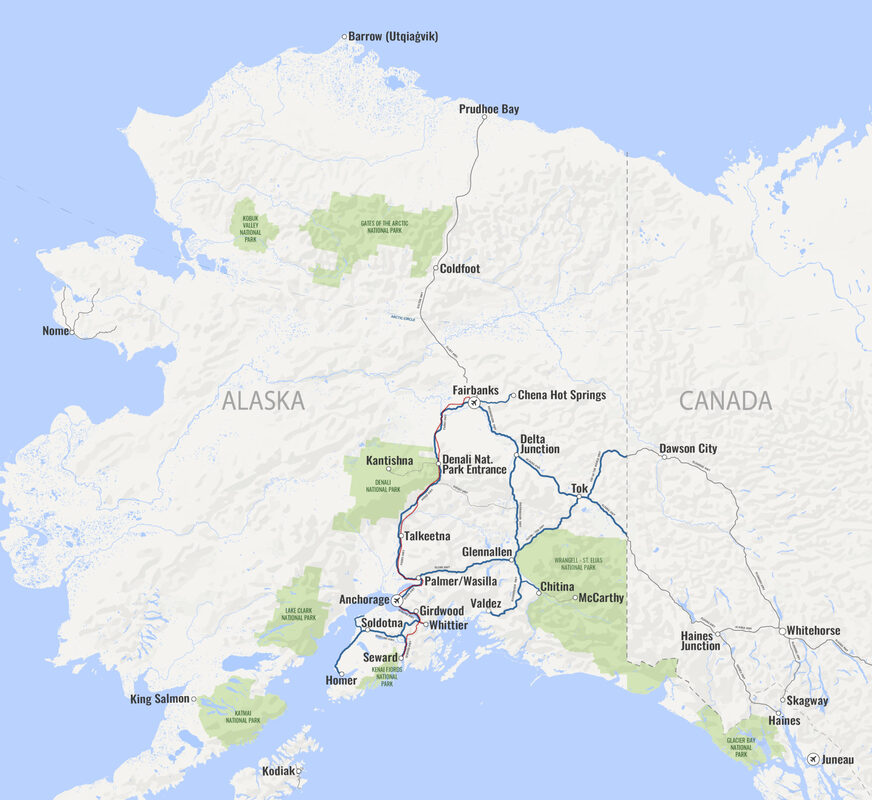Alaska's Brain bus did not start out as a brain bus
|
The Alaska Brain Bus is a 31foot long rolling piece of history.
The bus was built in Fort Valley Georgia in 1967 by the Wanderlodge Company which built high-end custom coaches on the Bluebird Bus chassis. The bus was very pricy when it was new and has seen several owners over the years. It appears that the original owner was none less than Senator Barry Goldwater. Now, the bus is ready to serve in a new way for the people of Alaska. |
Why this bus?
|
Where will the bus go?
|
The Alaska Brain Bus can go anywhere the is a road and a need. Many of the communities in Alaska with the highest rates of brain injury are reachable by road.
Other areas of Alaska such as Kodiak and South East communities are reachable by Ferry. Taking the Brain Bus on the ferry would be an expensive endeavor but anything is possible with community support. The bus is just a start. We hope to extend our reach beyond the road system once we prove this works. Why not have a Brain Boat or a Brain Plane? |
WHY does ALASKA NEED A BRAIN BUS?
From Dr Grove's perspective:
After having worked for almost 2 decades with traumatic brain injury (TBI) patients in Alaska, I was becoming increasingly concerned. Clinically, I was making good progress and helping people one at a time. But trying to help more people and those who couldn't access me was troubling. My efforts were a drop in the bucket for Alaskans with TBI.
I was a member of the Board of Directors of the Alaska Brain Injury Network (ABIN) for many years and spent a few years as Director of their board. During that time, our focus was on providing resources to as many people as we could with the limited resources we had. We learned a lot about what people with TBI in Alaska needed. While the work ABIN did during this time was amazing, it was also frustrating because, a vast number of brain injuries were and are happening outside of our focal area of Anchorage. While I was Director of the Board, I took and ran with an idea I heard about during a brain injury conference in Fairbanks. The idea was to form what we eventually called Brain Injury Outreach Clinics to take brain injury care to the rest of the state. These were pop-up clinics run by four or five volunteer professionals trained in brain injury. We would identify a community needing help, coordinate with that community and then fly the team to them for a two or three day visit during which we would provide educational presentations, screen community members and provide them with treatment recommendations and referrals. These clinics were funded by federal grant money received by the Alaska Brain Network. The federal grant funds were limited and State funds for ABIN faltered and diminished which brought the clinics to an end after a few years.
While these clinics were successful and we did a number of them throughout the state from Ketchikan to Utqiagvik, they were expensive and we were rarely able to return to the communities we visited to continue to provide the support they needed build sustainable local resources. As a result, most of traction we gained in those communities was not sustained.
After stepping down from the ABIN board, I joined the Traumatic and Acquired Brain Injury Advisory Council which works at the state level to provide guidance to state officials on how to meet the needs of Alaskans with brain injury. While this is important and ongoing work and we have a number of important initiatives underway, the board is not in a position to actually provide any services themselves. The Alaska Brain Injury Network is under funded and stopped providing direct services a few years ago. So what seemed a promising time for TBI services in Alaska, was short lived.
During the the 2019 COVID lock down, I began to think about ways we could help more people and not be dependent on whether they had insurance or lived in Anchorage. I was envisioning a mobile clinic which would function like the Brain Injury Outreach Clinics relying on volunteers to provide services but which also would operate on the road system so we would not have to pay for expensive plane tickets and hotel rooms. Furthermore, a mobile clinic, operating with lower costs, would enable us to return over and over to communities to build sustainable local resources. I begin to talk to my associates and patients about what I was calling the “Brain Bus”. The idea started to gain some traction but I was struggling with funding and organizing the effort.
I was ready to give up on the idea when two remarkable things happened. The first is that a patient, who has a brain injury herself, told me how she really wanted to help with the homeless situation in her neighborhood but had not been successful in getting any community backing. Rather than giving up, she decided that she would take matters into her own hands. She started collecting food which would otherwise have gone to waste, bought herself a little red wagon and started walking the streets handing out food and bottled water to the homeless. It struck me that she, even though she still is recovering from a brain injury, was making a difference. I decided at that point that I needed to take what Mahatma Ghandi said to heart; “You must be the change you wish to see in the world.” I would just have to start the “Brain Bus” project on my own right then with what I had. So I did.
The next amazing event happened two days later. A gentleman in California whose son sustained a TBI while serving in the military, contacted me and said that he had an old bus which he was willing to donate to the cause. I was overcome by his generosity and even when he explained that the bus still needed a bit of interior work and a few mechanical things done before it could be driven, all I could say was thank you for moving the dream forward!
I began to intensively research the bus and started to plan what it would take to make the bus roadworthy and get it up to Alaska. The trip from California to Alaska is no small matter. It is over 3000 miles. Just shipping a 31 foot long bus from Tacoma to Anchorage will cost around $6000 and I would still have to get the bus to Tacoma from the Bay Area which, would cost an additional $3,500 if shipped. Once it lands in Alaska, we will have to start building it out to work as a clinic on wheels and all of this needs to happen before the Spring 2022 launching of Alaska's Brain Injury Bus.
I think we can make it. We have to make it. So much depends on Alaska’s Brain Bus becoming a reality. It is time to harness the power of community and drive change. All aboard!
After having worked for almost 2 decades with traumatic brain injury (TBI) patients in Alaska, I was becoming increasingly concerned. Clinically, I was making good progress and helping people one at a time. But trying to help more people and those who couldn't access me was troubling. My efforts were a drop in the bucket for Alaskans with TBI.
I was a member of the Board of Directors of the Alaska Brain Injury Network (ABIN) for many years and spent a few years as Director of their board. During that time, our focus was on providing resources to as many people as we could with the limited resources we had. We learned a lot about what people with TBI in Alaska needed. While the work ABIN did during this time was amazing, it was also frustrating because, a vast number of brain injuries were and are happening outside of our focal area of Anchorage. While I was Director of the Board, I took and ran with an idea I heard about during a brain injury conference in Fairbanks. The idea was to form what we eventually called Brain Injury Outreach Clinics to take brain injury care to the rest of the state. These were pop-up clinics run by four or five volunteer professionals trained in brain injury. We would identify a community needing help, coordinate with that community and then fly the team to them for a two or three day visit during which we would provide educational presentations, screen community members and provide them with treatment recommendations and referrals. These clinics were funded by federal grant money received by the Alaska Brain Network. The federal grant funds were limited and State funds for ABIN faltered and diminished which brought the clinics to an end after a few years.
While these clinics were successful and we did a number of them throughout the state from Ketchikan to Utqiagvik, they were expensive and we were rarely able to return to the communities we visited to continue to provide the support they needed build sustainable local resources. As a result, most of traction we gained in those communities was not sustained.
After stepping down from the ABIN board, I joined the Traumatic and Acquired Brain Injury Advisory Council which works at the state level to provide guidance to state officials on how to meet the needs of Alaskans with brain injury. While this is important and ongoing work and we have a number of important initiatives underway, the board is not in a position to actually provide any services themselves. The Alaska Brain Injury Network is under funded and stopped providing direct services a few years ago. So what seemed a promising time for TBI services in Alaska, was short lived.
During the the 2019 COVID lock down, I began to think about ways we could help more people and not be dependent on whether they had insurance or lived in Anchorage. I was envisioning a mobile clinic which would function like the Brain Injury Outreach Clinics relying on volunteers to provide services but which also would operate on the road system so we would not have to pay for expensive plane tickets and hotel rooms. Furthermore, a mobile clinic, operating with lower costs, would enable us to return over and over to communities to build sustainable local resources. I begin to talk to my associates and patients about what I was calling the “Brain Bus”. The idea started to gain some traction but I was struggling with funding and organizing the effort.
I was ready to give up on the idea when two remarkable things happened. The first is that a patient, who has a brain injury herself, told me how she really wanted to help with the homeless situation in her neighborhood but had not been successful in getting any community backing. Rather than giving up, she decided that she would take matters into her own hands. She started collecting food which would otherwise have gone to waste, bought herself a little red wagon and started walking the streets handing out food and bottled water to the homeless. It struck me that she, even though she still is recovering from a brain injury, was making a difference. I decided at that point that I needed to take what Mahatma Ghandi said to heart; “You must be the change you wish to see in the world.” I would just have to start the “Brain Bus” project on my own right then with what I had. So I did.
The next amazing event happened two days later. A gentleman in California whose son sustained a TBI while serving in the military, contacted me and said that he had an old bus which he was willing to donate to the cause. I was overcome by his generosity and even when he explained that the bus still needed a bit of interior work and a few mechanical things done before it could be driven, all I could say was thank you for moving the dream forward!
I began to intensively research the bus and started to plan what it would take to make the bus roadworthy and get it up to Alaska. The trip from California to Alaska is no small matter. It is over 3000 miles. Just shipping a 31 foot long bus from Tacoma to Anchorage will cost around $6000 and I would still have to get the bus to Tacoma from the Bay Area which, would cost an additional $3,500 if shipped. Once it lands in Alaska, we will have to start building it out to work as a clinic on wheels and all of this needs to happen before the Spring 2022 launching of Alaska's Brain Injury Bus.
I think we can make it. We have to make it. So much depends on Alaska’s Brain Bus becoming a reality. It is time to harness the power of community and drive change. All aboard!



